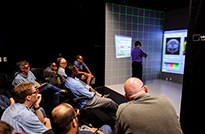UWyo MagazineOn Task
January 2014 | Vol. 15 No. 2
A bright new future is dawning for UW's energy and engineering programs with help from the state and successful graduates giving back to their alma mater.
By Micaela Myers
Impact. Pride. Leadership. Perhaps no group better exemplifies these words than the Wyoming Governor’s Energy, Engineering, STEM Integration Task Force—a group of impressive University of Wyoming graduates volunteering to help take the university’s energy and engineering programs to a bright new future.
They hold leadership positions at some of the nation’s top companies, as well as serving in government. Many graduated with engineering degrees from UW between the late 1950s and early 1980s and believe they received a stellar education that prepared them to enter a competitive workforce. That fantastic education, along with a passion for the state and university, motivated task force members to volunteer despite their already hectic schedules.
Task force co-Chairman Tom Botts (B.S., civil engineering, ’77) was executive vice president of global manufacturing for Royal Dutch Shell before his retirement and currently sits on the board for EnPro Industries Inc. and Wood Group. He notes that at one time three of five regions of Shell Global were led by folks from Wyoming. “In a way that goes to the work ethic, it goes to the quality of education we received, and it goes to emphasizing ethical leadership and all those things,” he says. “That has to be the hallmark for UW engineering—it certainly was 30 to 40 years ago, and we’ve got to make sure it stays that way.”
Co-Chairman Greg Hill (B.S., mechanical engineering, ’83), president and chief operating officer of Hess Corporation, says, “Given the opportunity to give back and help move this forward to again make us a top engineering school resonated with my passion for the state and the University of Wyoming.” Hill spent 25 years with Shell in top leadership positions before joining Hess. Both Hill and Botts have traveled the world with their international careers.
The task force also includes Chad Deaton, executive chairman (retired) of Baker Hughes Inc.; Eric Marsh, former executive vice president of Encana Corporation and senior vice president for the USA Division; Dick Agee, founder and chairman of Wapiti Energy LLC; Dave Bostrom, president and owner of Bostrom Enterprises LLC; Dave Freudenthal, former governor of Wyoming, attorney and board member of Arch Coal Inc.; Tom Lockhart, state representative and retired vice president of power systems for Pacific Power; and Phil Nicholas, attorney and state senator. Gov. Matt Mead tasked them with helping UW become a “Tier 1 academic and research institution in areas of excellence appropriate for Wyoming.”
“It is unprecedented for a university to bring together this caliber of alumni leadership who are at the pinnacle of the energy and engineering industries,” says UW Foundation President and CEO Ben Blalock.
This unprecedented partnership among the state, the university and the volunteers promises tremendous benefits for UW students, their eventual employers and even the nation, as future leaders and innovators are given the foundation they need to succeed.
“This is about changing the way we’re educating engineers and preparing them for the real world. We must connect them to the business world, as well as integrating engineering with other disciplines to solve tough problems that not only benefit external companies but benefit the state of Wyoming,” Botts says.
“The ultimate outcome is world-class students, world-class research in several niche areas, and jobs and economic development for Wyoming,” Hill adds.
Plan to Succeed
Mead created the task force in May 2012 to address the challenge set forth by the Legislature in House Bill 121, which called for an approach for UW becoming “Tier 1.” In his original charge letter, the governor said, “I have purposely chosen the name of this task force—the Governor’s Energy, Engineering, STEM Integration task force—to underscore the synergy that can be developed across the named segments. Investments made by the state, with extraordinary support from private sources, form a solid foundation from which to advance. … Your efforts will ultimately guide an investment of at least $100 million and one that should influence Wyoming, the university and the generations to come.”
The task force began its work by issuing a detailed report in the final quarter of 2012 with specific recommendations in eight categories. Among other things, the 36-page report stated: “Our recommended strategy has two primary elements. The first is investing to assure a challenging, ‘rock solid’ undergraduate engineering degree. This educational experience should be on par with those at any top-tier university with a solid reputation for engineering programs such as Purdue, Stanford, University of Texas, and the like. The second element of the strategy is to choose three to five graduate niches at which the University of Wyoming can genuinely excel. … The niches should relate directly (at least a number of them) to the state’s existing and future economy.”
To achieve this, the task force recommended defining areas of excellence, improving integration across colleges and facilities, enhancing undergraduate curriculum, improving the number and quality of faculty, recruiting quality students, improving connections with industry and alumni, investing in facilities, and providing leadership, execution and accountability.
UW added to the report in April 2013 with a written strategy by current UW Mechanical Engineering Professor Andy Hansen, titled “University of Wyoming Engineering Initiative: Toward Tier 1 for Wyoming,” that identified strategies for implementing the task force recommendations, including performance metrics and possible niche areas. The niche areas identified were: 1) unconventional reservoirs, 2) advanced coal technologies and energy conversion and delivery, 3) computational science and engineering for fluid dynamics and materials science, 4) water resources, and 5) biological and biomedical engineering.
Khaled Gasem, UW associate provost and interim dean of the College of Engineering and Applied Science, says the implementation plans will be managed by an Engineering Initiative Working Group in collaboration with the Implementation Team and the task force. Collectively, they will develop an operational plan that includes detailed timelines, clear milestones and measures of accountability.
“Another critical next step is broadening the engagement and really getting people energized throughout the university around the Tier 1 initiative and where we want to go,” Botts adds.
Former Gov. Freudenthal says of the task force, “Clearly this group is focused on those things that will allow us to use the momentum of the energy industry and resources it brings to create an environment where we produce students who are employable throughout the world.”
Wyoming students may even have a distinct advantage in the engineering field, says Rob Hurless, deputy director of the School of Energy Resources. “A lot of the young engineers coming out of school want to sit in an office behind a computer,” Hurless says. However, getting out on the rigs and in the field is also key. He spoke to many in the industry, and they reported positive things about young engineers from Wyoming. “The kids from Wyoming—whether it’s because they grew up in a rural area or it’s part of the work ethic here—they were perfectly comfortable going out and being in the field. In fact, some of them preferred it,” Hurless explains. “That was a really valuable asset and attribute.”
Real-world experience in Wyoming can combine with top-notch education and cutting-edge research to create an unstoppable group of graduates.
Cutting Edge
Close ties to businesses in the energy and engineering industries will benefit students and faculty in countless ways, from internships and guest lecturer opportunities to staying current—and being a part of—the latest advancements.
“Because of the dynamic culture of the energy industry, you can’t wait for textbooks to be written,” Blalock says. To future students, he adds, “This is a commitment for UW to ensure that your education is the most current when you walk out the doors of UW’s energy or engineering classrooms and labs.”
Botts says that’s the kind of education he received and what he wants to ensure future engineering students also receive. “When I started my career I was alongside people from all the world-class universities, and I quickly saw, ‘I can compete. I can stand right up beside these people and turn my hand to this stuff.’ That’s how kids have to leave this institution feeling. A lot of them are from ranches and farms, and a lot of them haven’t seen the world, but they’ve got to come out feeling, ‘I don’t have to just do what I know—I’ve got the skills to learn and do anything.’ ”
Working with industry leaders will give students on-the-job experience via internships. Hansen’s strategy report states, “UW’s College of Engineering and Applied Science aspires to have 90 percent of its graduates complete at least one professional internship by the time of graduation. The college will actively partner with prospective employers to achieve this goal.” The strategy report also addresses research, including 100 proposed fellowships: “The college will strive to create an atmosphere that promotes industry collaboration on research and academic programs that are responsive to the most current technologies utilized today.”
Hill sees this research as beneficial to the students, the state and the industry: “For the undergraduate students who want to go on to graduate school, I think they’ll have the opportunity to participate in extraordinary research—things that are going to make a difference.”
Achieving the Extraordinary
“As you continue to create this momentum, you’ll see a cascading effect throughout the university, and you’ll see a cascading effect throughout the state,” Freudenthal says. “Nothing succeeds like success, and you can see it around the work Mohammad Piri is already doing.” Piri, an associate professor in UW’s Department Chemical and Petroleum Engineering, studies multiphase flow in porous media with applications to oil and gas recovery.
Freudenthal says one person’s success can trigger others to achieve. “All of a sudden we begin to expect more of ourselves, and when we expect more of ourselves, we’ll do it.”
All those involved in the initiative are passionate and optimistic about what will be accomplished. As Hill says, “Wyoming’s hallmark is ‘ordinary’ people doing extraordinary things.”
Touring in 3-D

Visitors tour the Shell 3-D Visualization Lab at the UW Energy Innovation Center.
Detailed 3-D Models

The Shell 3-D Visualization Lab at the Energy Innovation Center can image detailed
3-D models.
UWYO MAGAZINE
The Magazine for Alumni and Friends of the University of Wyoming
Contact Us
UWyo Magazine
University of Wyoming
Dept. 3226
1000 East University Ave.
Laramie, WY 82071-2000
Phone: 307-766-2379
TTY: 307-766-6729
Email: uwyomag@uwyo.edu
University of Wyoming
Dept. 3226
1000 East University Ave.
Laramie, WY 82071-2000
Phone: 307-766-2379
TTY: 307-766-6729
Email: uwyomag@uwyo.edu
